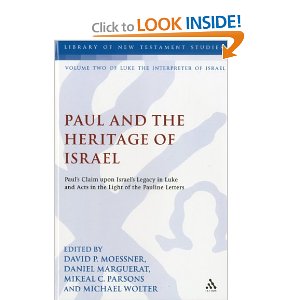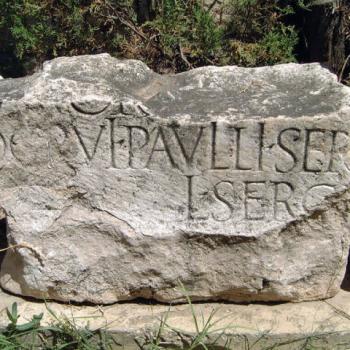Paul and the Heritage of Israel (eds. Moessner, Marguerat,Parsons,Wolter; T+T Clark 2012– uber-expensive– $92.00 on discount at Amazon, or about 35 cents a page of text!) is in fact volume two in a series entitled Luke the Interpreter of Israel. The first volume Jesus and the Heritage of Israel came out quite a while back (1999). This second volume has various merits, not the least of which is making available in English several important essays previously only in French. It also provides a certain status quaestiones coverage, particularly of what Continental scholars have thought about the book of Acts (see in particular the Forschungsberichte article by Odile Flichy, entitled “The Paul of Luke: Survey of Research” which does a good job with Continental scholarship while largely ignoring North American and to some degree even British scholarship on Acts [e.g. there is no mention at all of C.K. Barrett’s landmark ICC commentary on Acts, or those of yours truly, D. Bock etc.). The volume actually begins with yet another reprint of P. Vielhauer influential essay on the “Paulinism of Acts” in which he argues that the Paul of Acts is at variance with the Paul of the letters (who is the historical Paul) and that therefore the historical value of Acts is little or none. In particular he argued that Luke is unfamiliar with or misunderstands the theology of Paul. With a beginning like that, one might well ask what could justify the rest of the essays in this volume.
The third essay in the volume is an important one, a revision of an essay Richard Hays presented at the SNTS meeting in Aberdeen in 2006. Entitled, “The Paulinism of Acts: Intertexually Reconsidered”. It seeks to reply to Vielhauer’s essay, not least by showing that Paul himself was: 1) deeply indebted to the Scriptures of Israel, and 2) deeply rooted in a Jewish apocalyptic world view. He also stressses that Vielhauer cast his net too narrowly, looking only at the theology of a few speeches, when in fact he needed to consider the theology of Luke’s work writ large. Further, he points out that the Areopagus speech can hardly be called the zenith of Luke’s theologizing. The “rhetoric of the speeches in Acts is always carefully tailored to the apologetic situation within the unfolding plot of Acts, always keeping in view the symbolic world of the characters being addressed within the narrative setting” (p. 36). Hays will even argue that so Pauline is Luke’s vision of things, that he even recruits Peter to articular and support the Pauline Gospel and mission.
Hay’s approach to the comparison will be to ask whether Luke’s use of the OT bears close resemblance to Paul’s use of the OT, and indeed whether their aims are similar. It is Hays view that Luke and Paul belong to the same or same sort of interpretive Christian community and share an ‘encyclopedia of reception’ when it comes to Israel’s Scriptures. (p. 37).
Hays first port of call is the famous Pentecost speech of Peter in Acts 2. Here he points to the citation of Joel 2, particularly Joel 2.32 LXX cf. Acts 2.21. He then goes on to point out that Paul uses precisely the same text from Joel in Rom. 10.12-13 to support his case that the Gospel is a word of salvation for both Jew and Gentile alike. Furthermore, the term ‘Lord’ in the Joel citation is interpreted to mean Christ by both Peter in Acts and Paul in Romans. Hays then points to Ps. 110.1 certainly one of the most used verses in the NT to make Christological points and shows how it is used in both Acts. 2.34-35 and by Paul in 1 Cor. 15 to affirm the ultimate eschatological triumph of Christ over death.
Hays then turns to Acts 13.47 where Is. 49.6 is used to point to the mission of Paul and Barnabas to be a light to the Gentiles, and Israel as well. As Hays indicates, it is this same Isaianic text used in Gal. 1.15-16 (compare Is. 49.1-6 to these verses) and again in 2 Cor. 6.2 where Paul uses the text to define the nature of his calling or mission. Is. 49 then is key for defining and sustaining the Pauline mission in both Acts and Paul’s letters. Notice as well that ‘the servant’ in question in these NT texts is not Jesus, but rather Paul.
Hays then turns to Acts 28.25-28 and the citation of the judgment prophecy found in Is. 6.9-10. He takes this not as an example of Luke finally giving way to supercessionism, but as yet one more example of a prophecy meant to prompt repentance and a turning to Christ. This is the third time in Acts (13.46-48;18.5-6) where Paul talks of turning to the Gentiles but in neither of the previous ones does he give up going to the synagogue. Paul in Rom. 11.8 uses the same Isaianic material to explain why most Jews have rejected the Gospel and why his focus has been on Gentiles as a result. The Gospel must be offered to them first, and then to the Gentiles– an agenda quite clear in both Romans (see Rom. 1) and in Acts. In addition, Hays points to Rom. 11.9-10 where Ps. 68.23-24 LXX is cited, a Psalm used by Luke in Acts 1.20a to describe God’s judgment on Judas. The psalm is read in both cases as foreshadowing Jesus’ passion and death.
Turning from clear citation to Scriptural allusion, Hays focuses on Acts 10.34-43 and compares Rom. 10.9-12 and Rom. 5.1 where in all cases Is. 52.7 about sent ones preaching good news of peace seems to lie in the background. “In short, Peter’s opening words to Cornelius sound very much as though they could have been lifted out of the pages of Paul’s letter to the Romans” (p. 42). Hays then goes on to note that Peter refers to Jesus being raised ‘on the third day’ a possible allusion to Hos. 6.2 which we may also find referenced in 1 Cor. 15.4, noting that Paul indicates that this specific point is Scriptural (and cf. Lk. 18.32; 24.46). Hays then notes that Acts 10.34-35 references God’s impartiality (alluding to Deut. 10.17 and 2 Chron. 19.7) in the context of discussing the acceptance of Gentiles into God’s people, which is precisely how Paul uses the language of God’s impartiality in Rom. 2.1-16. “At the very least, this fundamental element of Luke’s theological programme stands within the trajectory launched by Paul’s theological justification for the mission to the Gentiles.” (p. 43). He goes on to note that both Luke and Paul tend to read the Psalms as the speech of Jesus (Acts 2.25-28; Rom. 15.3,9).
Hays then goes on to list at least 10 theological correspondences between Paul’s letters and what we find in Acts that were not previously referred to in his discussion (pp. 45-46). In other words, it’s not as if there was only a paucity of material that shows the correspondences between the two sources. Luke’s theology is more Jewish, more scriptural, and more kerygmatic than Vielhauer allowed. Hays then concludes “The theology of Acts can be seen as an organic outgrowth of the Pauline tradition that maintains it roots in at least some of Paul’s characteristic themes and concerns.” (p. 47). In short, what Paul planted, Luke watered in his narrative account of early Christianity (p. 48).













